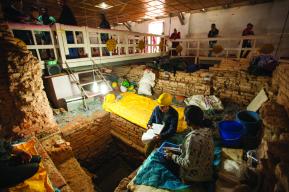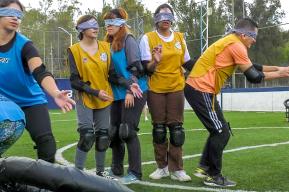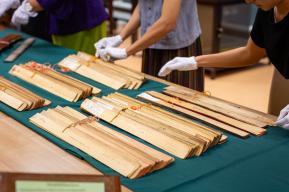Context:
The devastating earthquakes of 2015 that killed over 9,000 people and rendered hundreds of thousands of people homeless, severely damaged numerous monuments and sites in the Kathmandu Valley, surrounding districts and North-West area of Nepal. Within the Kathmandu Valley World Heritage property alone, Swayambhu along with the Hanumandhoka Durbar Square suffered the most. The 19-century unique style Mangal Bahudwar Chaitya, also known as the Tashi Gomang Stupa located to the south-west of the main Stupa (Mahachaitya) was no exception – it completely collapsed. Numerous sculptures and votive objects enshrined inside were exposed, soon becoming rubble of earth - a huge loss, but not for long with the faith of many devotees and local priest community to assemble back the pieces as unique testimonials!
Action:
UNESCO started taking action immediately after the earthquake joining hands with the local communities of Swayambhu, the Federation of Swayambhu Management and Conservation and Nepal’s Department of Archaeology for rapid damage assessment, emergency rescue and protection. A team of experts worked for several months with community experts for sorting and inventorying the valuable artefacts from the rubble and safeguarding them in a safe place until the rebuilding was completed in December 2017.
Thanks to the donors: the Hong Kong-based Fok Ying Tung Foundation, the Chinese Hainan Province Cihang Foundation, and the UNESCO Heritage Emergency Fund, for their generous support to rebuild the Stupa and to the recovery of Nepal’s cultural heritage.
Impact:
More than 100,000 small votive stupas (tsha-tshas) and 385 rare and valuable artefacts including coins and stone beads, bronze and copper chaityas, metal gods, gold coin with a repousse stupa, and a copper reliquary which were systematically photographed and inventoried were replaced back during the rebuilding of the Stupa. This has set an example of a successful project led by a multidisciplinary team of local skilled masons and crafts persons, knowledgeable priest communities - the local Buddhacharyas and volunteer students from the Tribhuvan University along with the experts from UNESCO and the Department of Archaeology.
A unique testimonial to the local community and a larger society because of the local priests community and their senior practitioners, who conducted a Kshyama Puja, a forgiveness ritual to start restoration and a Jeev-Nyas puja, a-day-long ritual to place the divinity of the Stupa back that marks the completion of rebuilding is an unprecedented example of continuing living traditions. Thousands of devotees now are able to continue their rituals. Monkeys are seen back playing in the niches that enshrined the Stupa.
The action has contributed towards Nepal’s efforts to attain SDG 11, and in particular towards the protection of world cultural and natural heritage.
Watch the video on the Restoration of the Stupa









